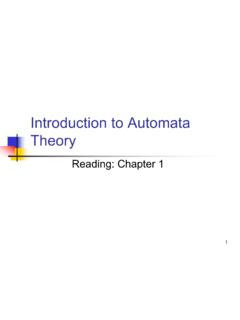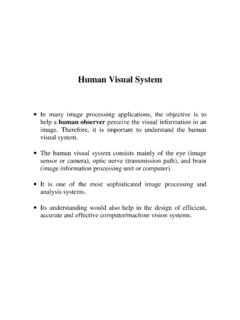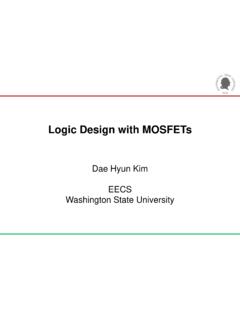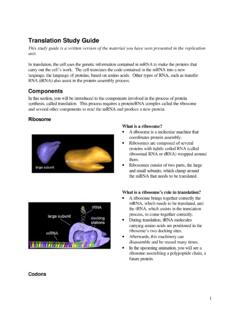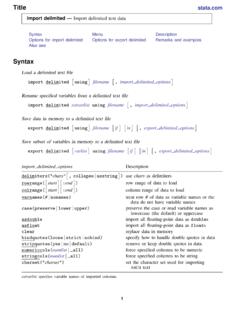Transcription of Pushdown Automata (()PDA)
1 Pushdown Automata (PDA)()Reading: Chapter 61 PDA - the Automata for CFLs What is? FA to Reg LangPDA is to CFL FA to Reg Lang, PDA is to CFL PDA == [ -NFA + a stack ]Wht k? Why a stack? -NFAI nputstringAccept/reject2A stack filled with stack symbols Pushdown Automata -Definition A PDA P := ( Q, , , ,q0,Z0,F ): Q: states of the -NFA : input alphabet :stack symbols :transition function q0:start stateZInitial stack top s mbol Z0:Initial stack top symbol F:Final/accepting states3old stateStack top input state(s)new Stack top(s) : Q x x =>Q x : The Transition Function (q,a,X) = {(p,Y).}
2 } transition from q to is the next input symbolX is the current is the current stack top is the replacement for X;it is in * (a string of stack symbols)Set Y =for:Pop(X)qpY= ?Actioni)Y= Pop(X) Y = for:Pop(X) Y=X: stack top is Y= : X is popped and is replaced byYini)Y= Pop(X)ii)Y=XPop(X)Push(X)iii)Y=Z1Z2 ZkPop(X)and is replaced by Y in reverse order ( , Z1will be the new stack top)iii) (X)Push(Zk)Push(Zk-1)..Push(Z2)4 Push(Z2)Push(Z1)ExampleLet Lwwr= {wwR| w is in (0+1)*} CFG for Lwwr:S==> 0S0 | 1S1 | PDA for Lwwr: P := ( Q, , , ,q0,Z0,F ) = ( {q0, q1, q2},{0,1},{0,1,Z0}, ,q0,Z0,{q2})5 Initial state of the PDA:qSt kPDA for LwwrZ0q0 Stacktop1.
3 (q0,0, Z0)={(q0,0Z0)}2. (q0,1, Z0)={(q0,1Z0)} (q00) {(q00)}First symbol push on stack3. (q0,0, 0)={(q0,00)}4. (q0,0, 1)={(q0,01)}5. (q0,1, 0)={(q0,10)}6. (q0,1, 1)={(q0,11)}Grow the stack by pushing new symbols on top of old(t)7. (q0, , 0)={(q1, 0)}8. (q0, , 1)={(q1, 1)}9 (q0 Z0)={(q1Z0)}(w-part)Switch to popping mode, nondeterministically(boundary between w andwR)9. (q0, , Z0){(q1, Z0)}10. (q1,0, 0)={(q1, )}11. (q1,1, 1)={(q1, )}(boundary between w and w)Shrink the stack by popping matching symbols (wR-part)612. (q1, , Z0)={(q2, Z0)}y(p)Enter acceptance statePDA as a state diagram (qi,a, X)={(qj,Y)}Next inputCurrentstackStackTo pinput symbolCurrentstatestacktopTo pReplacement(w/ string Y)qiqja, X / Y Nextstate7 PDA for Lwwr: Transition Diagram0, Z0/0Z01, Z0/1Z0 Grow stackPop stack for = {0, 1} = {Z0, 0, 1}Q={qqq}1, Z0/1Z00, 0/000, 1/011, 0/101, 1/110, 0/ 1, 1/ Pop stack for matching symbolsQ = {q0,q1,q2}q0q1q2 , Z0/Z0 , 0/0 , Z0/Z0G , Z0/Z0 , 1/1 Switch topopping modeGo to acceptance8 This would be a non-deterministic PDAE xample 2.
4 Language of pggbalanced paranthesisGrow stackPop stack for matching symbols = { (, ) } = {Z0, ( }Q={qqq}(, Z0 / ( Z0Q = {q0,q1,q2}(, ( / ( (), ( / q0q1q2Z/Z , Z0 / Z0G(bfi l)), ( / , Z0 / Z0 , Z0 / Z0 Switch topopping modeGo to acceptance (by final state)when you see the stack bottom symbo(, ( / ( ( (, Z0/ ( Z09To allow adjacentblocks of nested paranthesis(,0 (0 Example 2: language of balancedExample 2: language of balanced paranthesis (another design) = { (, ) } = {Z0, ( }Q={qq}(,Z0 / ( Z0(,( / ( (Q = {q0,q1}q(,( ( (), ( / startq ,Z0/ Z0q0q1 ,Z0/ Z010 PDA s Instantaneous Description (ID)A PDA has a configuration at any given instance: (q,w,y) qcurrent state q -current state w - remainder of the input ( , unconsumed part) y - current stack contents as a string from top to bottom ft kof stackIf (q,a, X)={(p, A)} is a transition, then the following are also true.))))))))))))))))))))))))))
5 (q, a, X) |--- (p, ,A)()|() (q, aw, XB ) |---(p,w,AB)|--- sign is called a turnstile notation and represents one move11|---* sign represents a sequence of movesHow does the PDA for Lwwrwwrwork on input 1111 ?(q0,1111,Z0)All moves made by the non-deterministic PDA(q0,111,1Z0)(q11 11Z)(q111 1Z)(q1,1111,Z0)Path dies(q0,11,11Z0)(q0,1,111Z0)(q1,11,11Z0) (q1,111,1Z0)Path (q0, ,1111Z0)(1111Z)(q 11Z)(q1,1,111Z0)(q1,1,1Z0)(q Z)Acceptance by final state:ti t12(q1, ,1111Z0)(q1, ,11Z0)(q1, ,Z0)(q2, ,Z0)= empty inputANDfinal statePath about IDs Theorem 1:If for a PDA, (q, x, A) |---* (p, y, B), then for any string *d *itilt thtw * and *, it is also true that: (q, x w, A ) |---* (p, y w, B ) Theorem 2: If for a PDA, (q, x w, A) |---* (p, y w, B), then it is also true (q,,)|(p, y,),that.
6 (q, x, A) |---* (p, y, B)13 There are two types of PDAs that one can design: those that accept by final stateor by empty stackAcceptance PDAs that accept by final state: For a PDA P, the language accepted by P, dtdbL(P)bfi l t tidenoted by L(P)by final state, is: {w | (q0,w,Z0) |---* (q, , A) }, , q F Checklist:- input exhausted?- in a final state? PDAs that accept by empty stack: For a PDA P, the language accepted by P, denoted by N(P)by empty stack, is: {w | (q0,w,Z0) |---* (q, , ) }, for any q Q. 14{|(q0,,0)|(q,,)},yqQChecklist:- input exhausted?- is the stack empty?Q) Does a PDA that accepts by empty stackneed any final state specified in the design?
7 Example: L of balanced pparenthesisPDA that accepts by final state(Z/(ZAn equivalent PDA that accepts by empty stack(,Z0 / ( Z0(,( / ( (), ( / (,Z0 / ( Z0(, ( / ( (), ( / ,Z0 / PF:PN:q0), ( / startq1 ,Z0/ Z0 Z0/Z0q0start Z/Z ,Z0/ Z0 ,Z0/ Z015 How will these two PDAs work on the input: ( ( ( ) ) ( ) ) ( ) PDA for Lwwr: Proof of wwrcorrectness Theorem:The PDA for Lwwraccepts a string x by final state if and only ifx is of the form RwwR. Proof: (ifpart)If the string is of the formwwRthen there (if-part)If the string is of the form wwRthen there exists a sequence of IDs that leads to a final state: (q0,wwR,Z0) |---* (q0,wR,wZ0) |---* (q1,wR,wZ0) |---* (q Z)|*(q Z)(q1, ,Z0) |--- (q2, ,Z0) (only-if part)16 Proof by induction on |x| PDAs accepting by final state and emptyPDAs accepting by final state and empty stack are equivalent PF<= PDA accepting by final state PF= (QF, , , F,q0,Z0,F) PN<= PDA accepting by empty stack PN= (QN, , , N,q0,Z0)Th Theorem.))))))))))))))
8 (PN==> PF) For every PN, there exists a L(PF)=L(PN) (PF==> PN) For every PF, there exists a L(PF)=L(PN)17 How to convert an empty stack PDA into a final state PDA?PN==> PFconstruction Whenever PN s stack becomes empty, make PFgo to a final state without consuming any addition symbol To detect empty stack in PN:PFpushes a new stack symbol X0(not in of PN) initially before simultating PNN ,X0/X0PF: , X0/Z0X0 New start , X0/ X0 , X0/ X0 , X0/ X0PF:N , X0 / X018 , X0/ X0 PNPF= (QNU {p0,pf}, , U {X0}, F, p0, X0, {pf})Example: matching parenthesis ( ) PN:( {q0}, {(,)}, {Z0,Z1}, N, q0, Z0 ) N: N(q0,(,Z0) = { (q0,Z1Z0) } (q(Z)={(qZZ)}Pf:( {p0,q0 ,pf}, {(,)}, {X0,Z0,Z1}, f, p0, X0 , pf) f.))
9 F(p0, ,X0) = { (q0,Z0) } (q(Z)={(qZZ)} N(q0,(,Z1) = { (q0, Z1Z1) } N(q0,),Z1) = { (q0, ) } N(q0, ,Z0) = { (q0, ) } f(q0,(,Z0) = { (q0,Z1 Z0) } f(q0,(,Z1) = { (q0, Z1Z1) } f(q0,),Z1) = { (q0, ) } f(q0, ,Z0) = { (q0, ) } f(p0, ,X0) = { (pf, X0) }(,Z0 /Z1Z0(,Z1 /Z1Z1),Z1 / ,Z0/ (,Z0/Z1Z0(,Z1/Z1Z1),Z1/ Z0/ q0start0 q0 ,Z0/ startp0pf ,X0/Z0X0 ,X0/ X0 19 Accept by empty stackAccept by final stateHow to convert an final state PDA into an empty stack PDA?PF==> PNconstruction Main idea: Whenever PFreaches a final state, just make an -transition into a new end state, clear out the stack and acceptnew end state, clear out the stack and accept Danger: What if PFdesign is such that it clears the stack midway without entering a final state?))))
10 To address this, add a new start symbol X0(not in of PF) ,y0(F)PN= (Q U {p0,pe}, , U {X0}, N, p0, X0)PN:p0 , X0/Z0X0 New start , any/ , any/ , any/ PN:20 , any/ PFEquivalence of PDAs andEquivalence of PDAs and CFGs21 CFGs == PDAs ==> CFLsPDA by final statePDA byempty stack ?CFG22 This is same as: implementing a CFG using a PDA Converting CFG to PDAMain idea:The PDA simulates the leftmost derivation on a given w, and upon consuming it fully it either arrives at acceptance (by empty stack) or nonacceptanceempty stack) or (wacceptUTPUT(acceptance by empty stack)wrejectINPUOUTP implements23 CFGThis is same as: implementing a CFG using a PDA Converting a CFG into a PDAMain idea.
